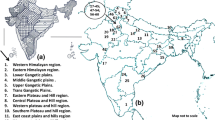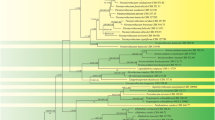Abstract
Sixty-seven isolates of the southern blight fungus from Japan were divided into five groups based on ITS-RFLP analysis of nuclear rDNA. Morphological characters of sclerotia varied between groups. Three groups were reidentified asSclerotium rolfsii, and two resembledS. delphinii in RFLP patterns and/or in having large sclerotia and relatively low optimal growth temperature (28°C). Sclerotia of the latter, however, varied in size according to temperature and became indistinguishable from those ofS. rolfsii at high temperatures. Hyphal anastomosis (imperfect fusion) was observed between different ITS-RFLP groups, as well as between different isolates belonging to the same groups. These results indicate that populations of this fungus in Japan consists of several different subgroups, although morphological differences are not always evident.
Similar content being viewed by others
Literature cited
Boerema, G. H. and Hamers, M. E. C. 1988. Check-list for scientific names of common parasitic fungi. Ser. 3a: Fungi on bulbs: Liliaceae. Neth. J. Pl. Pathol. 94 Suppl.1: 1–32.
Carling, D. E. 1996. Grouping inRhizoctonia solani by hyphal anastomosis reaction. In:Rhizoctonia species: taxonomy, molecular biology, ecology, pathology and disease control, (ed. by Sneh, B., Jabaji-Hare, S. and Neate, S.), pp. 37–47. Kluwer Academic Publ., Netherland.
Chowdhury, N., Dey, T. K. and Khan, A. L. 1993. Effect of culture media, light, temperature and pH on the mycelial growth and sclerotia formation ofSclerotium rolfsii Sacc. Bangladesh J. Bot.22: 149–153.
Goto, K. 1930. On the perfect stage ofSclerotium rolfsii Sacc. produced on culture media. J. Soc. Trop. Agr.2: 165–175.
Harlton, C. E., Levesque, C. A. and Punja, Z. K. 1995. Genetic diversity inSclerotium (Athelia) rolfsii and related species. Phytopathology85: 1269–1281.
Ishii, M. and Tezuka, N. 1994. Southern blight ofEupatorium japonicum, obedient plant, toadlily and potato caused bySclerotium rolfsii. Proc. Kansai Pl. Prot.36: 79–80. (In Japanese.)
Ishikawa, S., Hayama, K., Nakayama, K. and Tezuka, N. 1992. Occurrence of strawberry southern blight caused bySclerotium rolfsii Sacc. Proc. Kanto Pl. Prot. Soc.39: 125–127 (In Japanese.)
Morikawa, C., Okabe, I. and Matsumoto, N. 1997. Genetic diversity inSclerotium rolfsii and related species. Ann. Phytopathol. Soc. Japan63: 207. (In Japanese).
Nakata, K. 1926. Studies onSclerotium rolfsii Sacc. part 3. Perfect form of the fungus and its genetic relationships toHypochnus centrifugus (Lev.) Tul.,H. solani Pril. et Delacr. andH. cucumeris Fr. with its specific relationship toSclerotium coffeicolum Stahel. Bull. Sci. Fak. Ter. Kjushu Imp. Univ.2: 7–19. (In Japanese).
Nishihara, N. 1961. Misc. publ. Chiba-ken Agric. Exp. Sta.1, pp. 6–8. (In Japanese).
Nonaka, F., Motomura, T. and Tanaka, K. 1990. Study on southern blight like disease of water chestnut (Trapa bispinosa Roxb.). 1.Corticium rolfsii Curzi isolated from water chestnut. Proc. Assoc. Pl. Prot. Kyushu36: 56–58. (In Japanese).
Ogoshi, A. 1976. Studies on the grouping ofRhizoctonia solani Kuhn with hyphal anastomosis and on the perfect stages of groups. Bull. Natl. Inst. Agric. Sci. Ser. C30: 1–63. (In Japanese).
Okabe, I., Morikawa, C., Yokoyama, K. and Matsumoto, N. 1997a. Lack of anastomosis group differentiation in strains ofSclerotium rolfsii. Ann. Phytopathol. Soc. Japan63: 207. (In Japanese).
Okabe, I., Morikawa, C., Matsumoto, N. and Yokoyama, K. 1997b. Intraspecific variation in rDNA internal transcribed spacer regions ofSclerotium rolfsii. Proc. 11th Australasian Plant Pathol. Soc. Conf., 314.
Punja, Z. K. 1988.Sclerotium (Athelia) rolfsii, a pathogen of many plant species. In: Advances in plant pathology 6, (ed. by Sidhu, G. S.), pp. 523–534. Academic Press, San Diego, CA.
Punja, Z. K. and Damiani, A. 1996. Comparative growth, morphology, and physiology of threeSclerotium species. Mycologia88: 694–706.
Punja, Z. K. and Grogan, R. G. 1983. Basidiocarp induction, nuclear condition, variability, and heterokaryon incompatibility inAthelia (Sclerotium) rolfsii. Phytopathology73: 1273–1278.
Punja, Z. K., Grogan, R. G. and Adams, G. C., Jr., 1982. Influence of nutrition, environment, and the isolate, on basidiocarp formation, development, and structure inAthelia (Sclerotium) rolfsii. Mycologia74: 917–926.
Saccardo, P. A. 1911. Notae mycologicae. Ann. Mycol.9: 249–257.
Sambrook, J., Fritsch, E. F. and Maniatis, T. 1989. Agarose gel electrophoresis. In: Molecular cloning, pp. 6.3–6.34. Cold Spring Harbor Lab. Press, New York.
Sato, T., Nakanishi, T. and Koganezawa, H. 1995. Southern blight of yacon (Polymnia sonchifolia) caused bySclerotium rolfsii Saccardo. Proc. Assoc. Pl. Prot. Shikoku30: 79–84. (In Japanese).
Sawada, K. 1912a.Hypochnus on cultivated plants in Formosa. Shokubutsugaku-zasshi26: 125–138. (In Japanese).
Sawada, K. 1912b.Hypochnus on cultivated plants in Formosa. (continued from p. 138.) Shokubutsugaku-zasshi,26: 177–193. (In Japanese).
Shoji, T. 1993. Southern blight of little club mossSelaginella tamariscina caused bySclerotium rolfsii. Proc. Kanto Pl. Prot. Soc.,40: 179–180. (In Japanese).
Shoji, T. 1996. Occurrence of southern blight ofEupatorium fortunei caused bySclerotium rolfsii. Proc. Kanto Pl. Prot. Soc.43: 123–124. (In Japanese).
Stevens, F. L. 1931. A comparative study ofSclerotium rolfsii andSclerotium delphinii. Mycologia23: 204–222.
Takeuchi, J. and Horie, H. 1993. Occurrence of southern blight ofPeperomia caperata, Ophiopogon japonicus f.nanus andAjuga repens caused bySclerotium rolfsii in Tokyo. Proc. Kanto Pl. Prot. Soc.40: 163–165. (In Japanese).
Tezuka, N. and Ishii, M. 1994. Southern blight of gladiolus, coneflower, yellow lupine, sweet william and columbine caused bySclerotium rolfsii. Proc. Kansai Pl. Prot.36: 81–82. (In Japanese).
Tezuka, N., Ishii, M. and Horiuchi, S. 1992. Southern blight of chard, strawberry, edible burdock, scallion, tatarian aster andAster pilosus. Proc. Kansai Pl. Prot.34: 75–76. (In Japanese).
Uematsu, S., Kodama, K. and Nakamura, Y. 1993. Sclerotium rot ofAlstroemeria spp.,Nerine bowdenii, Phalaenopsis hybrids,Solanum mammosum andTulbaghia fragrans caused bySclerotium rolfsii. Proc. Kanto Pl. Prot. Soc.40: 171–174. (In Japanese).
Uematsu, S., Takahashi, T. and Sekiyama, K. 1992. Sclerotium crown rots ofDelphinium elatum, × Solidaster luteus andChlorophytum comosun caused bySclerotium rolfsii. Proc. Kanto Pl. Prot. Soc.39: 163–165. (In Japanese).
Welch, D. S. 1924. A sclerotial disease of cultivatedDelphinium. Phytopathology14: 31.
White, T. J., Bruns, T., Lee, S. and Taylor, J. 1990. Amplification and direct sequencing of fungal ribosomal RNA genes for phylogenetics. In: PCR protocols: a guide to methods and applications, (ed. by Innis, M. A., Gelfand, D. H., Sninsky, J. J. and White, T. J.), pp. 315–322. Academic Press, San Diego, CA.
Author information
Authors and Affiliations
About this article
Cite this article
Okabe, I., Morikawa, C., Matsumoto, N. et al. Variation inSclerotium rolfsii isolates in Japan. Mycoscience 39, 399–407 (1998). https://doi.org/10.1007/BF02460900
Accepted:
Issue Date:
DOI: https://doi.org/10.1007/BF02460900




